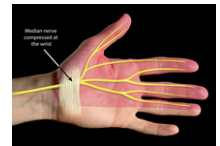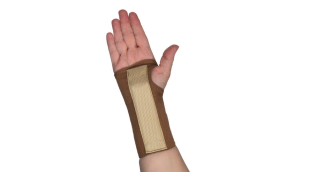Carpal tunnel syndrome (CTS)
To view this page as a PDF; Click here
What is Carpal Tunnel Syndrome (CTS)?
One of the main nerves supplying the hand is called the median nerve. This nerve passes into the hand through a passage called the carpal tunnel. Occasionally, this nerve can get squashed in this tunnel. This is called carpal tunnel syndrome. This can cause symptoms such as numbness, pain, and pins and needles in certain parts of your hand. It can occur at night and sometimes during certain activities in the day. Your fingers may feel stiff and swollen. In more severe cases it can cause weakness and difficulty holding objects.

What causes CTS?
CTS can occur during pregnancy, following a broken wrist, thyroid problems, or arthritis. Some types of work or sustained positions such has holding a book can make the symptoms worse. Some other conditions can mimic the symptoms, including diabetes and arthritis of the neck. Often the symptoms are eased by moving the hand
How is CTS diagnosed?
The specialist who assesses you may be able to diagnose CTS without special tests but in some cases a Nerve Conduction Study (NCS) is helpful in confirming the condition. NCS is a test to measure the ability of a nerve to transmit impulses normally. In cases of suspected Carpal Tunnel Syndrome the median nerve will be tested along with other nerves to be certain that your symptoms are not due to something else.
What treatments are available to treat CTS?
Some cases will settle without any treatment
1. Self-Management Strategies:
a) Wrist Support
Milder cases can be treated with a wrist support, which helps to keep the wrist straight, making the carpal tunnel bigger and taking pressure off the nerve. The supports can be worn at night to prevent the wrist from resting in a bent position whilst sleeping. It can be used during daily tasks, but only for short periods of time to prevent muscles from weakening.
Supports are available in chemists without a prescription or you may choose to order on line. The picture below shows the type of support which can help.

b) Exercises
Some health professionals believe that certain exercises can help with hand and wrist movement and the median nerve to glide gently through the carpal tunnel and help to may improve symptoms. Examples of exercises include:

These exercises can be repeated 2-5x each a few times a day. Keep your wrist and fingers moving during these exercises. DO NOT hold the positions.
c) Other Strategies
The easiest way to get relief from carpal tunnel syndrome is to avoid actions that compress the front of the wrist and irritate the symptoms, such as:
- Sleeping with the wrist bent
- Holding a phone for a long time
- Typing or texting for extended periods
- Holding a book or tablet up for a long time
- Leaning on the wrist
- Driving for a long time
Additional techniques you can try at home include:
- Rest the hand, wrist and arm when possible.
- Anti-inflammatory/pain relief medications. However, check with your GP or Pharmacist if you are on any other medications.
- Kinesiotaping; This is a tape which can be used to help the body’s natural heling process. There are video links online to demonstrate various taping techniques to help with this condition. You may need to try several to see which works best for you. Suggested links are at the end of this leaflet.
- Consider modifying activities that you perform regularly, so that there is less pressure on your wrist, particularly during long periods of time. For example; ensure your chair is the correct height if using a computer, or consider a gel wrist support to rest your wrists or headset rather than holding a phone.
2. Other treatments that your doctor may recommend:
a) Steroid Injection / Water Tablets
Steroid Injections into the wrist can help to reduce pain. Sometimes the injections are used when diagnosis is difficult if the pain is very severe. Water tablets work in some cases. You will need to discuss these options with your GP.
b) Surgery
When symptoms are severe or do not improve with the other treatments, then an operation may be needed. This is called a Carpal Tunnel Decompression. This is usually performed as a day case which means you will go home the same day as your operation. This is usually done under a local anaesthetic, meaning you are not put to sleep.
The operation involves the roof of the carpal tunnel being released, taking the pressure off the nerve. It usually take 10-14 days for the wound to heal. You will be encouraged to keep your fingers, thumb and wrist moving within the dressing to help reduce any swelling or stiffness, and undertake light activity such as eating, dressing.
Further information on the procedure will be provided by the specialist if this is the option of choice.
Rydym yn croesawu gohebiaeth a galwadau ffôn yn y Gymraeg neu'r Saesneg. Atebir gohebiaeth Gymraeg yn y Gymraeg, ac ni fydd hyn yn arwain at oedi. Mae’r dudalen hon ar gael yn Gymraeg drwy bwyso’r botwm ar y dde ar frig y dudalen.
We welcome correspondence and telephone calls in Welsh or English. Welsh language correspondence will be replied to in Welsh, and this will not lead to a delay. This page is available in Welsh by clicking ‘Cymraeg’ at the top right of this page.